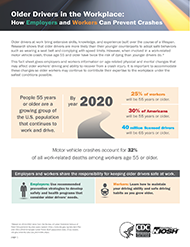How Employers Can Keep Older Drivers Safe at Work
Posted on byMotor vehicle crashes are the leading cause of work-related deaths in the United States. Millions of workers, such as long-haul truck drivers, sales representatives, and home health care staff, drive or ride in a motor vehicle as part of their jobs. As our workforce ages, we need to pay special attention to the needs of older drivers in the workplace. The NIOSH Center for Motor Vehicle Safety recently released a new fact sheet that provides employers and workers information on age-related physical and mental changes that may affect older workers’ driving, as well as resources and checklists for workers and employers to promote safe driving strategies.
Between 1994 and 2014, employment of older workers (65 years and older) increased by 117%, and this trend is expected to continue (BLS). By 2020, it is estimated that 30% of Americans and 25% of all workers will be 55 years and older, and 40 million licensed drivers will be 65 years and older.[i] Physical and mental changes that are a normal part of aging – such as declining eyesight, hearing, physical strength, and memory – can affect one’s ability to drive safely. However, the relationship between aging and safe driving is not so simple. Older individuals tend to practice better driving habits, such as wearing seat belts and following speed limits, and they are less likely than younger persons to be involved in a crash. But, they are at a higher risk of injury or death if involved in a crash, in part because the body becomes more vulnerable to severe injury with age.
Safety Policies and Training for Older Workers
It is important for employers to accommodate the needs and capacities of older workers through safety policies and training so they may continue to contribute their experience and expertise to their organization. When developing a safety program for older drivers, employers should take into consideration the normal physical and mental changes that come with aging. A safe driving program should include standard program elements such as policies and practices related to seat belt use, cell phones, and distracted and drowsy driving. Employers can also incorporate principles of journey management and flexible scheduling that may be particularly beneficial for older drivers; for example, planning routes in advance, allowing flexible work hours that keep workers off the road at peak congestion times, or authorizing workers to stop overnight if they are too tired to continue driving. Also, “refresher” training can provide drivers the opportunity to learn safe-driving strategies, changes in state laws on seat belts and cell phones, proper car fit, and advanced vehicle safety features. When conducting safety training programs, employers should consider giving a sufficient amount of time to absorb material, allowing for spacing of practice, leveraging older workers’ preexisting knowledge, offering behind-the-wheel training, and using visual elements in training programs. Employers should be open to discussing workers’ concerns related to driving and develop travel plans based on those conversations. Employers should also note that advanced safety features in vehicles can be daunting for older drivers in particular. MyCarDoesWhat.org explains safety features such as automatic emergency braking and adaptive cruise control in interactive formats designed to fit the learning styles of drivers of all ages.
Employers can use the expertise of older workers’ “crystalized” intelligence — their extensive bank of skills, knowledge, and experience accumulated over the course of the lifespan. This accumulated knowledge is a valuable resource that can be leveraged in the form of mentoring programs that could help create and maintain an organizational safety climate that benefits workers of all ages. Older drivers can transfer the knowledge they have accumulated about driving safely in different types of weather, roads, and traffic patterns to less-experienced drivers.
An added benefit of workplace motor vehicle safety programs is the potential to reach beyond the workplace to personal driving practices and those of workers’ families, friends, and communities. For every employee who participates in a motor vehicle safety program, there are a number of other road users who can benefit from their experience.
Help us distribute the new fact sheet to workplaces where driving is part of the job. Let us know what your workplace has done to improve safety for older drivers.
For more information on aging workers and aging-friendly workplaces, visit the National Center for Productive Aging and Work which promotes lifelong well-being for workers and encourages a productive aging workforce.
For more information on preventing work-related motor vehicle crashes,visit the NIOSH Center for Motor Vehicle Safety, which conducts research and promotes evidence-based strategies for safer driving at work.
Rosa L. Rodríguez-Acosta, PhD, is the Assistant Director of the NIOSH Center for Motor Vehicle Safety.
Rebecca Olsavsky, MS, is a Health Communications Specialist Fellow in the NIOSH Center for Motor Vehicle Safety.
James Grosch, PhD, is a Research Psychologist in the NIOSH Division of Applied Research and Technology and Co-Director of the National Center for Productive Aging and Work.
Harpriya Kaur, MPH, is an ORISE Fellow in the NIOSH Division of Applied Research and Technology.
Bermang Ortiz, BA, is a Public Health Associate in the NIOSH Education and Information Division.
Juliann Scholl, PhD, is a Health Communication Fellow in the NIOSH Education and Information Division and Co-Director of the National Center for Productive Aging and Work.
[i] NIOSH [2016]. Older drivers in the workplace: how employers and workers can prevent crashes. By Rodriguez-Acosta R., Pratt S. and Olsavsky, R. Morgantown, WV: U.S. Department of Health and Human Services, Centers for Disease Control and Prevention, National Institute for Occupational Safety and Health, DHHS (NIOSH) Publication 2016–116.
Posted on by


